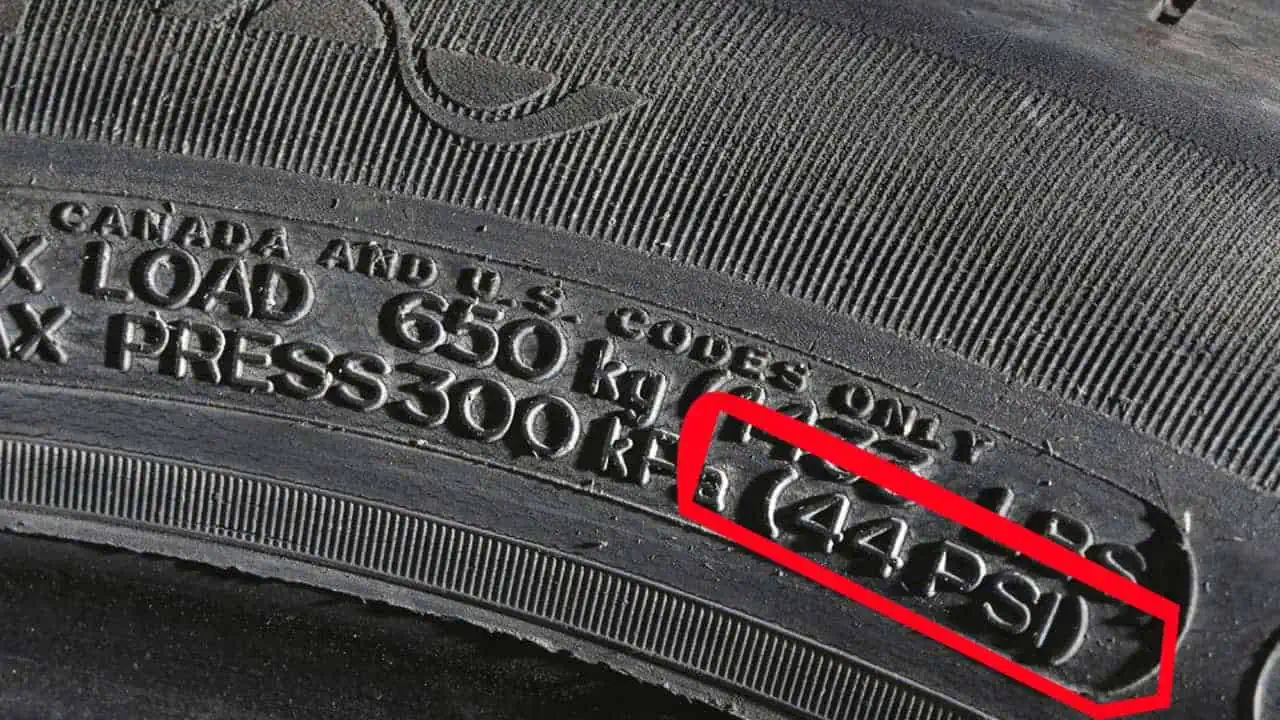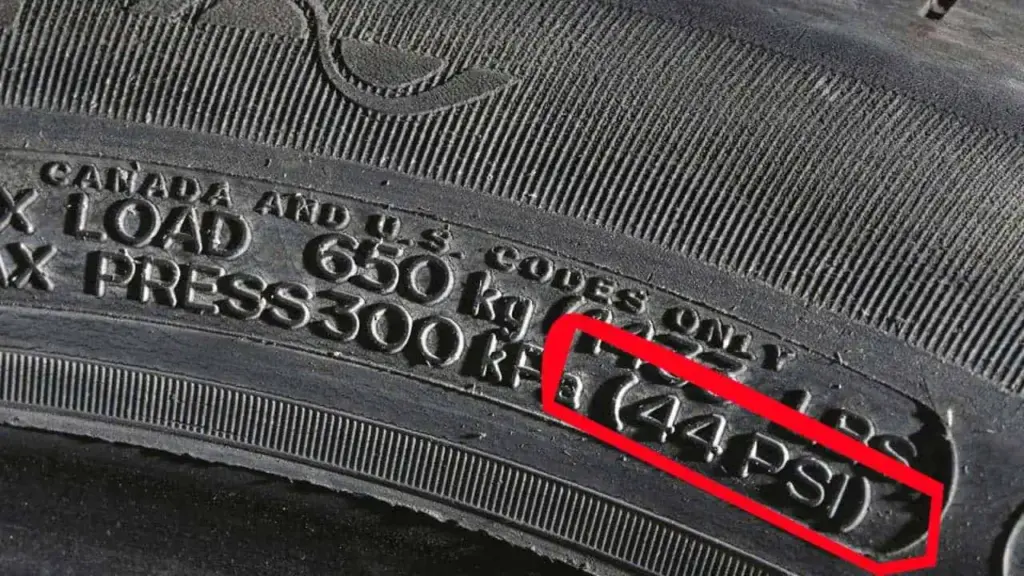It’s astonishing to consider that a simple number on our tires can significantly impact the safety and performance of our vehicles. This number, followed by the unit “psi,” isn’t just a trivial detail; it’s a crucial indicator of the tire’s inflation pressure. Proper tire pressure ensures optimal vehicle handling, tire longevity, and fuel efficiency.
The “psi” stands for pounds per square inch, a measurement of the air pressure inside the tire. Historically, the concept of tire pressure was developed over a century ago, revolutionizing the way we understand vehicle dynamics. For instance, maintaining the manufacturer-recommended psi can increase tire life by up to 4,700 miles, making it not just a matter of safety but also cost-efficiency.

What does the psi number on the tire stand for?
The psi number on a tire stands for “pounds per square inch.” This measure indicates the amount of air pressure inside the tire. Proper tire pressure helps with vehicle handling, tire wear, and fuel efficiency. It’s a tiny number that has a huge impact on your driving experience. Keeping an eye on it can save you a lot of trouble.
Essentially, psi is a way to measure the force exerted by the air within the tire. Each vehicle has a recommended psi, typically listed on a sticker inside the driver’s door or in the owner’s manual. For cars, the recommended psi usually ranges from 30 to 35. It’s essential to follow these guidelines for optimal performance. Ignoring it can lead to poor handling and increased tire wear.
Over-inflating or under-inflating your tires can cause problems. For example, over-inflated tires may result in a bumpy ride and increased wear in the center of the tire. Under-inflated tires can lead to poor fuel efficiency and increased wear on the edges. Both conditions can be hazardous and costly. Here are some outcomes of incorrect tire pressure:
- Decreased fuel efficiency
- Increased tire wear
- Poor vehicle handling
- Higher risk of tire blowouts
Regularly checking your tire pressure is simple but often overlooked. Most gas stations have air pumps with psi gauges. You can also buy a portable tire pressure gauge. Always check your tire pressure when the tires are cold, as heat can cause the air inside to expand, giving a false reading. Maintaining the correct psi is a key part of vehicle safety and performance.
Decoding PSI: Understanding Pounds per Square Inch
PSI stands for “pounds per square inch,” a unit of measure for pressure. In the context of tires, it quantifies how much air pressure is inside the tire. This measurement is crucial for maintaining optimal tire performance. Proper PSI ensures the best grip on the road and efficient fuel consumption. Without the right psi, driving can become less safe and more expensive.
Think of PSI as the level of inflation your tire needs to function correctly. Too much psi can make your tires firm and cause a harsh ride. Too little can cause your tires to sag and wear unevenly. Both conditions can affect how your car handles. That’s why manufacturers specify the ideal psi for each vehicle.
Having a proper understanding of psi can also improve the lifespan of your tires. Improperly inflated tires wear out faster and can even suffer from blowouts. For instance, under-inflation can lead to overheating, which is a common cause of tire blowouts. It’s not just about comfort; it’s about safety as well. Here are some key benefits of maintaining correct psi:
- Better fuel efficiency
- Improved vehicle handling
- Longer tire lifespan
- Reduced risk of blowouts
Checking your tire’s psi regularly is essential. You can do this easily with a portable tire gauge or at a gas station. Always check the tire pressure when your tires are cold for the most accurate reading. Adjust the psi to match the manufacturer’s recommendation, usually found in the owner’s manual or on a sticker inside the driver’s door. This simple step can go a long way in ensuring your vehicle’s safety and performance.
The Role of PSI in Tire Safety and Performance
PSI plays a vital role in ensuring tire safety and performance. Proper tire pressure helps maintain the vehicle’s stability and handling. Tires with the correct PSI grip the road better and increase braking efficiency. Incorrect PSI can lead to poor handling and even accidents. Maintaining the right PSI is essential for a safe driving experience.
Vehicle performance is closely linked to tire pressure. Under-inflated tires create more friction with the road, making the engine work harder. This can reduce fuel efficiency and lead to higher fuel costs. Over-inflated tires, on the other hand, reduce the contact area with the road. This can lead to a rougher ride and increased wear in the tire’s center.
Safety risks associated with improper PSI shouldn’t be underestimated. Under-inflated tires are prone to overheating, which can cause blowouts. Over-inflated tires are more susceptible to damage from road hazards. Both conditions can reduce the lifespan of your tires. Here’s a quick comparison:
| Under-Inflated Tires | Over-Inflated Tires |
|---|---|
| Increased friction | Reduced traction |
| Poor fuel efficiency | Rough ride |
| Blowout risk | Tire damage |
Regularly monitoring and maintaining the correct PSI is both simple and critical. Tire pressure should be checked at least once a month and before long trips. It’s also important to do this when the tires are cold. Proper PSI not only ensures optimal performance but also extends the life of your tires. This proactive habit can prevent many potential hazards on the road.
How Different PSI Levels Affect Your Drive
Different PSI levels can significantly impact how your vehicle drives. Under-inflated tires can cause sluggish handling and increased friction. This friction can generate more heat, increasing the risk of a blowout. Low PSI also leads to faster tire wear, especially on the tire edges. It makes your vehicle less fuel-efficient too.
Over-inflated tires are another concern. When the PSI is too high, the ride becomes bumpier as the tire does not absorb road shocks well. This can cause uneven tire wear, especially in the center. Over-inflation also reduces the contact area of the tire with the road. This makes it harder to control your vehicle, especially in wet conditions.
Even within the recommended PSI range, slight variations can affect performance. For example, a difference of just a few PSI can alter how a car handles turns. Excessively high PSI can make your car feel skittish, especially at higher speeds. Slightly lower PSI might give a smoother ride but can compromise performance. Adjusting PSI to match driving conditions can optimize both comfort and control.
The impact of PSI levels can also vary based on the vehicle type. Sports cars might require higher PSI for better handling. SUVs might need lower PSI to handle rough terrains better. Follow recommendations specific to your vehicle for the best results. Always consider your driving environment when adjusting PSI.
Regular monitoring is the key to maintaining the right PSI. Use a tire gauge and adjust as needed. This habit ensures an optimal driving experience year-round. Checking PSI isn’t difficult and can prevent many driving issues. It’s a small task with big benefits in safety and performance.
Understanding the effects of different PSI levels helps in making well-informed decisions. Here’s a quick list summarizing the impacts:
- Under-inflation: Increased friction, faster wear, lower fuel efficiency
- Over-inflation: Bumpy ride, uneven wear, reduced control
- Optimal PSI: Better handling, safer driving, longer tire lifespan
Keep those points in mind for a smooth and safe drive.
Recommended PSI for Different Vehicles
Different vehicles have specific PSI recommendations to ensure safety and performance. For regular passenger cars, the recommended PSI usually falls between 30 and 35. This range offers a balance of comfort, fuel efficiency, and tire longevity. Always check the owner’s manual or the sticker inside the driver’s door for precise numbers. Following these guidelines will ensure a smoother drive.
SUVs often require a slightly higher PSI. Due to their larger size and weight, they typically need tires inflated to around 35 to 40 PSI. This helps in supporting the extra load and maintaining stability. Properly inflated tires also enhance off-road capabilities. Adhering to these recommendations ensures that your SUV handles well under different conditions.
Trucks, especially those used for towing or carrying heavy loads, have even higher PSI requirements. These vehicles might need tires inflated to 40 to 45 PSI or more. This higher pressure helps to support the additional weight and avoid tire damage. Failing to maintain the correct PSI can lead to uneven wear and potential blowouts. Ensuring that truck tires are properly inflated is crucial for safety on the road.
Sports cars often need higher PSI than regular cars. This is because higher PSI can improve handling and performance. Sports cars typically require tires inflated to around 35 to 40 PSI. Properly inflated tires help the car remain stable during high-speed maneuvers. It’s essential for achieving the best possible performance.
Motorcycles also have specific PSI requirements, usually listed in the owner’s manual. Motorcycle tires tend to need higher pressures, around 32 to 42 PSI depending on the type of bike and riding conditions. Proper tire pressure is crucial for balance and traction. Always check both front and rear tire pressures for the best riding experience.
The Impact of Proper PSI on Fuel Efficiency
Maintaining the correct PSI in your tires significantly impacts fuel efficiency. Under-inflated tires create more rolling resistance, meaning the engine has to work harder to move the vehicle. This increased effort leads to higher fuel consumption. By ensuring proper tire pressure, you can reduce this resistance. This helps the car to run more efficiently and conserves fuel.
Incorrect PSI doesn’t just affect fuel efficiency; it can impact overall vehicle performance. Over-inflated tires can lead to a rigid ride and reduced traction. This not only makes the ride less comfortable but also less safe. On the other hand, properly inflated tires provide better contact with the road. This improves both traction and control, which are crucial for safe driving.
Investing in a portable tire gauge can help you keep an eye on your tire pressure. Checking your tires at least once a month can ensure they are at the optimal PSI. Properly inflated tires can improve your car’s fuel mileage by up to 3%. While this might not seem like a lot, it can add up over time. Consistently maintaining the right PSI can save you money.
The benefits of maintaining the correct PSI are clear. It not only saves fuel but also prolongs the life of your tires. Under-inflated tires wear out quicker, leading to more frequent replacements. Here’s a quick look at how proper PSI affects fuel efficiency:
- Reduces rolling resistance
- Enhances vehicle handling
- Lowers fuel consumption
- Decreases CO2 emissions
These benefits highlight the importance of keeping your tires properly inflated.
Another key aspect is environmental impact. Lower fuel consumption means fewer emissions, benefiting the environment. Proper PSI also ensures that your tires perform at their best throughout their lifespan. It’s a simple yet effective way to contribute to eco-friendly driving. Ensuring your tires have the correct PSI is a win-win for both you and the planet.
Conclusion
Understanding the importance of PSI in your vehicle’s tires is crucial for both safety and performance. Properly inflated tires ensure better handling, improved fuel efficiency, and reduced tire wear. Ignoring PSI can lead to serious consequences, including accidents and higher operating costs.
Regularly checking and maintaining the correct PSI is a simple task with significant benefits. It not only keeps you safe but also saves money in the long run. Make tire pressure checks a regular part of your vehicle maintenance routine for optimal performance.


Leave a Reply